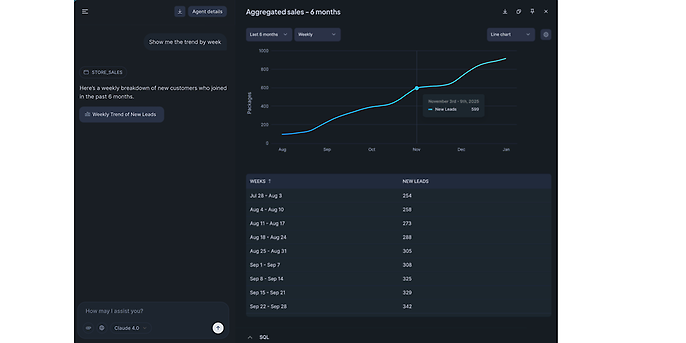18. November 2025 By Mahlyar Ahmadsay
Snowflake Intelligence: Just ask your data
Data queries have never been easier: Snowflake Intelligence transforms your data analysis into a natural conversation. Instead of complicated SQL queries, simple questions are all you need – and the answers come in seconds. This blog post shows how companies can gain deep insights in seconds without any SQL knowledge.
Answers in seconds instead of days
Today's companies face the challenge of having to make decisions faster and faster. In the past, extensive analyses by data experts were necessary to obtain answers to important business questions. Today, all it takes is a simple question that any employee can ask without technical know-how. With Snowflake Intelligence, companies can obtain answers from their data in seconds without having to perform complex queries or spend days on evaluations. This fundamentally changes the way organisations work with their data.
What is Snowflake?
Snowflake is a cloud-based data platform that helps companies securely store, process and analyse data. Whether it's financial data, customer information or logistics processes, Snowflake makes it possible to centrally bundle large amounts of data and make it accessible to different departments. Find out more about Snowflake at snowflake.com.
What is Snowflake Intelligence?
Snowflake Intelligence is another product from Snowflake that uses artificial intelligence (AI) to enable complex analyses and evaluations based on company data simply by asking questions in natural language. Users can enter their questions directly via a user-friendly interface reminiscent of a chatbot. For example: ‘What was the turnover in the Dortmund branches in each quarter of 2024?’
Instead of complex queries or analysis scripts, natural language input is all that is needed to obtain meaningful insights immediately.

The Snowflake Intelligence Dashboard with AI-powered data analysis. Source: https://ai.snowflake.com
What exactly can Snowflake Intelligence do?
Snowflake Intelligence enables you to perform complex analyses and evaluations using simple queries. The underlying agent automatically generates the necessary SQL statements, explains them to you and then executes them. Snowflake Intelligence can display the data returned by the query graphically, for example in the form of a diagram.
Snowflake Intelligence offers a choice of different AI models, including Claude 4.0 and GPT-4.1, which also enable more in-depth reasoning (conclusion/consideration). This further increases the accuracy of the output. In addition, analysis queries can receive a correctness seal. This confirms that the accuracy of the query has been verified by the data team. This further increases confidence in the agents' responses.
Data Driven
From data chaos to a data-driven company
Data is the engine of digital transformation. But without structure, strategy and meaningful networking, it remains untapped potential. With a clear data strategy and modern architecture, we transform your data masses into real added value – for better decisions, automated processes and sustainable innovation.
But what data does Snowflake Intelligence use? The agent behind Snowflake can extract data from all databases stored in Snowflake, as well as from external sources such as Salesforce or Confluence. Snowflake Intelligence can also read and analyse PDFs, images and other unstructured data, and access the Snowflake Marketplace.
An example of this would be to obtain the latest news from a company (e.g. a news service) that provides its data in the Snowflake Marketplace and use it to explain which events could influence the company's key figures. Increased sales figures in a Cologne restaurant belonging to a food franchise could, for example, be attributed to a trade fair taking place in the area at the same time.
In addition, Snowflake's Semantic Model offers the possibility to reuse existing business logic from familiar BI tools and to map and define it centrally in Snowflake via semantic views. An example of this is the direct upload of Tableau data source files to transfer existing metric and dimension definitions to Snowflake. This eliminates the need to maintain KPIs twice and allows Snowflake Intelligence to pick up, interpret and reproduce them.
The Semantic Model is therefore an excellent way to provide Snowflake Intelligence with deeper context about the data, processes and business logic available in the company.
How does Snowflake Intelligence work?
Now let's move on to another exciting question: How does Snowflake Intelligence work?
Snowflake Intelligence is an AI agent that combines the capabilities of the Snowflake Cortex Analyst Service and the Cortex Search Service. Cortex Search focuses on searching unstructured data, while Cortex Analyst answers business questions based on structured data.
Instead of fixed agent types, Snowflake Intelligence uses configurable archetypes: based on semantics, search and tools, three function profiles can be created, which can be freely combined as required.
The General Knowledge Agent
The General Knowledge Agent is like a built-in, AI-powered assistant that combines general knowledge from a language model with your company data. It answers questions such as ‘How do you calculate customer lifetime value?’ or ‘What is EBITDA?’ and can understand uploaded contexts and business contexts using the native semantic model.
The agent that uses the Semantic View in Cortex Analyst
This agent functions like an intelligent analyst who already knows your business logic. It converts natural language into correct, governance-compliant data queries based on centrally defined key figures, ensuring that everyone sees the same KPIs.
The agent that uses the Cortex Search Service
This agent is like an intelligent enterprise search assistant that makes unstructured information findable in natural language, thereby supplementing the semantic model with knowledge documents.
What are the advantages of Snowflake Intelligence?
A major advantage of Snowflake Intelligence is that it promotes data democracy: every department and every employee can interact directly with the data and thus make informed decisions. This saves time, reduces costs and increases the agility of the entire company. Data democracy also allows every user to ask critical questions and receive in-depth answers in no time at all. This generates new ideas and insights at a speed that was previously impossible in the company.
Another advantage of Snowflake Intelligence is that data for ML and AI use cases, as well as for analyses and dashboards, no longer has to leave Snowflake. This increases security, reliability and performance while reducing costs.
Conclusion
Snowflake Intelligence makes data accessible, understandable and usable for everyone in the company. Instead of manually creating complex analyses, users can now simply ask their questions and receive accurate answers within seconds. This means less effort, greater efficiency and a significant increase in competitiveness.
With this innovation, Snowflake is taking an important step towards data democratisation. Companies that use their data in this way not only create transparency, but also a solid foundation for sustainable success.
We support you!
Experience how Snowflake Intelligence revolutionises your data analysis. Our experts support you in using Snowflake Intelligence – for faster insights, informed decisions and true data democracy.

